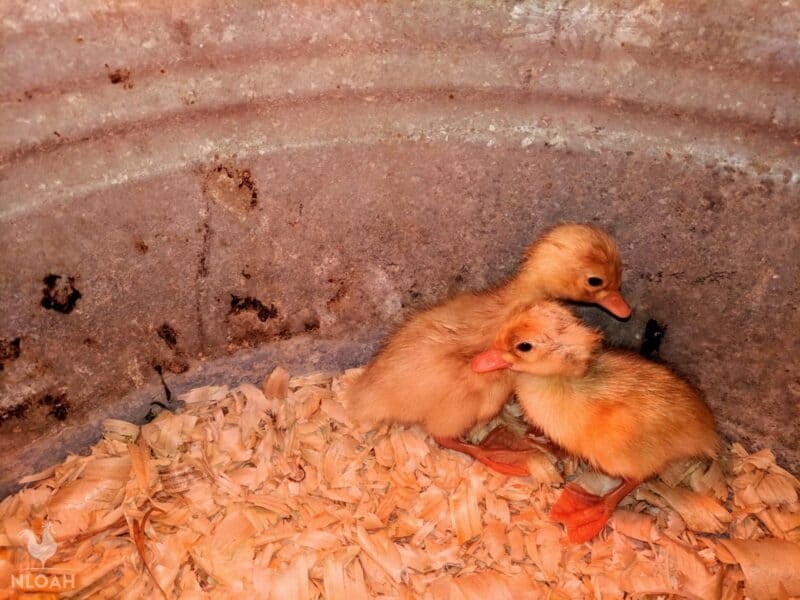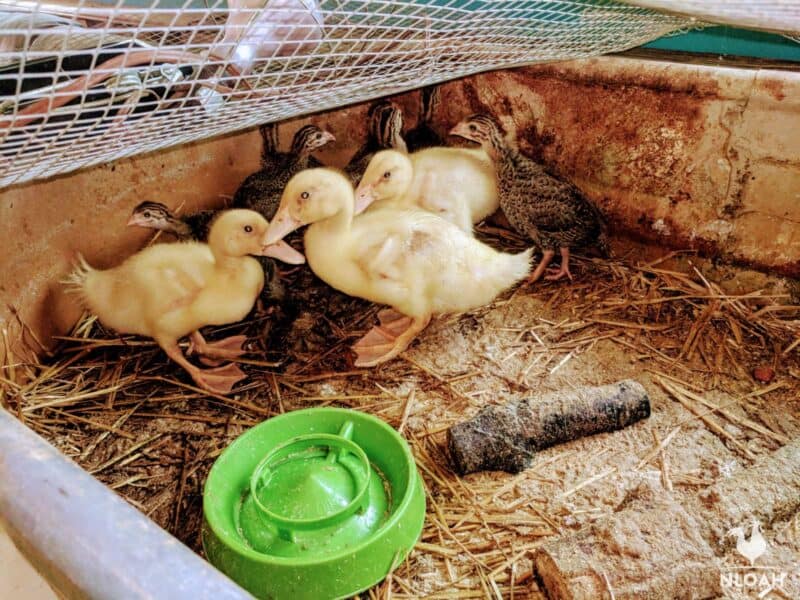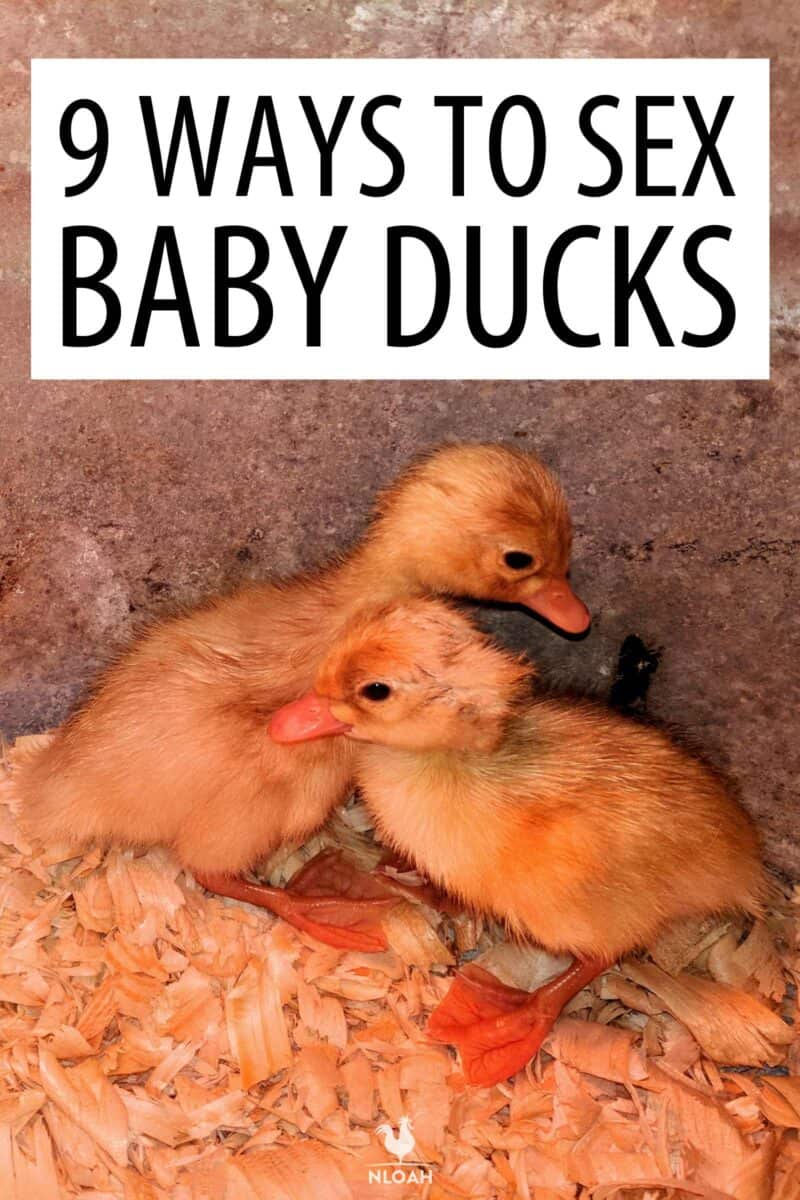Learning the sex of ducklings can be a puzzling yet interesting endeavor. All of the cute little baby ducks in your brooder or incubator might look and sound identical at first glance, but there are slight yet distinct differences between the future drakes and hens.

Table of Contents:
Duck Sexing Quick Comparison Table
| Feature | Female Ducks | Male Ducks |
|---|---|---|
| Drake feathers | Females don’t develop these feathers… | They develop 1 or 2 curly feathers called drake feathers |
| Size and weight | Smaller, lighter, and shorter | Larger, heavier, and taller |
| Voice | Louder quack after 6 months | Quack not as loud as a female’s after 6 months |
| Feet | Smaller webbed feet | Larger webbed feet (even disproportionate) |
| Duckling behavior | Female ducklings are more energetic | Male ducklings are more lethargic |
| Vent checking (not recommended) | Females have an oviduct | Males have a thin penis |
Vent Sexing (Checking)
Although there are several different visual and audio cues (covered below) that can alert you to the sex of ducklings, there is really only one foolproof way to determine how many males and females you have: checking the duckling’s anal vent – cloaca.
Checking a duckling’s vent to sex it can harm or cause mortal injury to the poultry bird if done improperly.
Even though there are ample videos showing you how to check a duckling’s cloaca to sex it online, this act should really only be undertaken by a veterinarian or a trained and experienced breeder.
Because a duck’s reproductive organs and nestled entirely inside of their bodies, verifying sex involves some intricate maneuvering. When a vent is checked properly, the ducklings are not injured or traumatized by the act.
If you apply too much pressure on either the cloaca itself or the duckling’s belly to extend the vent slightly outside of the body, severe internal damage could occur.
Vent Method Steps
Put the duckling on a table. While cloacal examinations have been conducted successfully earlier, it is best to wait until the baby duck is at least 12 days old.
Again, I cannot stress strongly enough how dangerous it can be to conduct a vent check if you are not properly trained. Vent checking a duckling for sex determination is far more difficult than sexing a mature duck because of both its small size and fragility.
Position the duckling so its legs are positioned away from you and its chest is facing up. The duckling’s tail should hang over the end of the table so the vent can easily be exposed.
Find the vent. It is a tiny external opening in the rear end area of the duckling. The duckling’s reproductive tract ends at the vent. Feel along the feathers around this rear end area of the duckling very gently to find the cloaca opening.
Place thumbs on either side of the vent and then slowly and gently (emphasis on gently) pull the vent slightly apart.
Expose the walls of the cloaca and the duckling’s genitals to see if the poultry bird is a male or a female.
A duck penis will protrude from the vent. A female duck will have an oviduct opening in the vent. vent walls and genitals by folding the tail down and in the opposite direction pressing gently upward.
In male ducklings and older but still immature ducks, the penis is sheathed but in mature ducks, it is unsheathed.
As shown in the video below, the duckling vent should only be opened gently and not very wide for an absolute maximum of 30 seconds:
Less intrusive means to garner a better-than-educated guess at a duckling’s sex can be easily conducted by amateur duck keepers.
Plumage Duckling Sexing Method
One of the simplest and least intrusive ways to sex ducklings is by a thorough review of their feathers. Not all duck breeds have feathering that is easily distinguishable at a young age, but many domesticated and wild varieties do.
Pekins, Anconas, Magpies, Swedish, and Cayugas are prime examples of duck breeds that do not have plumage that differs by sex – especially at the duckling stage. Indian Runners and Welsh Harlequin ducks are among the breeds that offer easy sexing by plumage.
Researching the breed of duck you are keeping will help you learn what specific feathering colors and styles can help indicate sex.
Keep in mind, that it is not uncommon for some ducklings to present only female plumage until they are close to three months old.
Once ducklings are nearing this age the presence of a “drake feather” should develop. A drake feather is one or two curly feathers among the other tail feathers on a male duck. Female ducks do not have any type of curly tail, all of their tail feathers remain flat.

Although none of the Pekin ducklings in the photo above have a drake feather yet, you can still tell distinct differences between the shape of the tails in the two ducklings in front on both screen right and screen left, respectively.
The duckling the on right side of the photo will likely be a female because its tail feathers are grouped closely together. A male’s tail feathers are typically grouped further apart, and fan out.
Size Matters
To reinforce your attempt to sex ducklings by plumage you can also take size into consideration. Even from an extremely young age, male ducklings are larger and heavier than female ducklings.
Welsh Harlequin, Mallard, and Rouen duck breed females commonly have thicker necks and larger heads than males.
The Voice
If you are raising a breed of duck that does not have differing plumage and the size difference is so slight you still are not sure of the sex, there is one more way you can help determine if the cute little fuzz ball is a male or a female.
Just close your eyes, pick up a little duckling, separate it from the rest of the tiny flock, and then listen carefully. Ducks that are less than six weeks old often sound nearly alike, but that soon changes.
After the six-month milestone, female ducks develop a louder and more demanding sounding quack, while males have a more pleasant or softer sounding quack. In my personal experience, female ducks make a far more honking sound than males – especially when excited or angry.
Listen to the different sounds male and female ducks make by clicking here.
Seasonal Changes
Some breeds of ducks can successfully hide their sex from visual or audio inspection quite well except during the peak of breeding season. The Freckled duck breed is one of these varieties. During breeding season only the male Freckled duck develops a red color on its bill.
Bills
Some duck breeds show a distinct difference in their bill color and even shape year-round, not just during the breeding season.
While this visual cue can be very helpful in determining the sex of a duckling, it does not apply to all domestic duck breeds and cannot be accomplished until the birds are usually a few months old.
Some duck breeds boast hens with orange bills or orangish-brown colored bills and drakes with green bills. Sometimes the difference in color or shape is so slight that there is still a lot of guesswork when attempting to discern sex using this method.
Muscovy, Appleyards, Rouens, Indian Runners, Khaki Campbells, and Welsh Harlequins are good examples of duck breeds that can have bill differences that may help with sexing the poultry birds.
Muscovy drakes (male Muscovy ducks) develop a bill that is wider, flatter, and straighter than a hen of the same breed. Female Muscovy ducks have far less of a platypus-style bill. These hens have bills that include a ridged middle and are more curvy, pointy, and narrow in shape than a drake of9 the same breed.
Black Runner and Fawn Runner ducks all have dark bills when they are hatched, but color differences start to appear as they age. Abacot Ranger females have a dark green bill, but males of this same breed have a bill that is a lighter shade of green.
Feet
The cute little webbed feet on male ducklings can often appear disproportional to those of female ducklings. Even before you can use body size difference to help determine the sex of ducklings, the difference in foot proportion may be evident.
Male duckling feet are not only typically larger than a female’s feet but the legs themselves often tend to be bulkier when compared to the more slender legs of a female.
The tiny male ducklings also often have a wider stance than females and tend to step on their own big webbed feet more often than female ducklings.
Duckling Behavior
A male duckling is sometimes less active than his female brooder peers – perhaps because of the awkwardness that can be created due to the quick growth of their feet and legs.
During their first few weeks of life, you can watch the ducklings interact in the brooder to determine if any of the little fuzz balls look a bit lazy or at least less active. The more lethargic ducklings might just be males.
Learn more about duck behavior here.
Wing Growth
In some duck breeds, wing growth can help determine the sex of ducklings. Female ducklings tend to develop true feather sprouts on their wings as well as around their bellies and tails than male ducklings.
Carefully inspecting and monitoring the fuzz-to-feather development of each duckling’s wings can be a fairly reliable method of sexing them.
When looking over the wings for feather sprouts, also pay attention to the weight, and feel of the wings. A female duckling’s growing wings tend to lose that paper-thin feel a lot more quickly than a male duckling.
Sexing Ducks By Breed
Sexing Mallard Ducklings
As already mentioned female mallards are active and more vocal than males. The black line that cuts through the eye is more prominent in male mallard ducklings, while in females it’s more faded.
Male mallard baby ducks have a dark brown bill, while females have a lighter brown bill.
Sexing Pekin Ducks
This is easy. Pekin female ducks are louder and have more energy than male ducks. In fact, male Pekin ducks don’t really quack, it’s more of a muffled quack. A female’s duck is more orange than a male’s.
Sexing Muscovy Ducklings
Popular backyard ducks, Muscovy ducklings reach sexual maturity and start to mating at seven months old. Males have a wide flat bill while females have a narrower, curvy bill. Additionally, females are lighter and grow feathers faster than males.
Male Muscovy ducklings have larger feet than females and are capable fliers – though they can’t fly as fast as their female counterparts. Their vocalizations are also different with females having a very quiet trilling sort of voice and males having a hoarse sounding voice.
What Is A Sex-Linked Duck?
If you purchase a sex-linked duckling, there is no need to attempt to determine its sex. These ducklings and other poultry birds are bred so breeders can sex the poultry birds when they are “day olds.”
This process produces a down on the ducklings that creates a phenotypic expression – or sex linkage. The gender of the duckling is tied directly to sex chromosomes that produce a male or female down-related color. Down is the fuzzy pre-feathers that cover a duckling’s body when it is born.
In 1930 R. C. Punnett wrote in the journal, Nature that it might be possible to establish the gender of ducklings based solely upon feather color. It took another two years for Punnett to find a way to actually produce sex-linked ducklings in the breeding offspring he was working with during testing.
Wrap Up
Learning how to sex ducklings can help in both flock and breeding planning. The healthiest male-to-female ratio for ducks is one mature drake per every three females.
Knowing how many future drakes are in your recent hatch will quickly allow you to plan the sale of any unneeded males – or how many more females you will need to keep all of the adorable little fuzzy ducklings.


Tara lives on a 56 acres farm in the Appalachian Mountains, where she faces homesteading and farming challenges every single day, raising chickens, goats, horses, and tons of vegetables. She’s an expert in all sorts of homesteading skills such as hide tanning, doll making, tree tapping, and many more.

Thanks Tara very well described